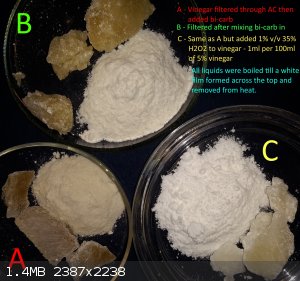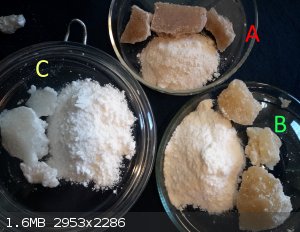RogueRose
International Hazard
    
Posts: 1593
Registered: 16-6-2014
Member Is Offline
|
|
Cleaning up Sodium Acetate from vinegar (removing brown color)
I made some Na Acetate from vinegar a couple months ago and it came out perfectly clear in the tri-hydrate form. After dissolving (with DH2O) and
recrystallizing it took on a slight light blue tint - very faint but noticeable in low-moderate light.
I then made another batch, using the same vinegar brand and bi-carb but this time I ran it through an activated carbon filter (2" diam x 4" long) at
about 1L per 5 mins - so a pretty slow filter rate - followed by a sub-micron filter (same type used for many other applications that come out 100%
clear after carbon filtering).This time the acetate turned the light brownish color that many of us have seen - especially in the hydrated form. When
it gets hot enough to form the anhydrous, it seems to stay white.
What I'm curious about is how it can be either brown or white, both in the same hydrate form. I thought it might be b/c the carbon filtering, leaving
some organic material in it. The thing is, I've done this process before and on my first attempt I had the brownish result then used this carbon
filter after re-hydrating the product and boiled till dry-ish (90% water removal followed by slower evaporating). This resulted in pure white hydrate
- so I didn't think the carbon interfered with the acetate.
So what I was wondering is whether sodium acetate or acetic acid (or possibly bi-carb or dissolved CO2) can act upon carbon and dissolve it into the
solution. If there was an excess of any of the components when going through the filter, could any of those have dissolved some carbon to make this
darker?
I don't think there is anything wrong with the product due to the color, but IDK. I'm wondering if it might be better to filter the vinegar first,
before adding a carbonate.
Has anyone worked with this and figured any of it out?
*note: I forgot to mention a question I had about possibly removing the brown color by using some H2O2 in the solution at some point. I know it is
used in acids like H2SO4 to remove organics but IDK if that only works b/c the additional oxidative effect of the acid (and temp maybe). The liquid
has to be boiled down either way so adding some H2O2 prior to boiling, allowing to sit for some time (maybe stirring would help as well) and then
boiling contents. If this would work, would 3% work if enough is added? Surely less 35% would be needed and it will be diluted in either case to
lower molarity. How much might be effective if this would work and would it oxidize the sodium acetate?
[Edited on 8-3-2017 by RogueRose]
|
|
|
JJay
International Hazard
    
Posts: 3440
Registered: 15-10-2015
Member Is Offline
|
|
I made some a while back and found it to be more of a hassle to make that way than it was really worth if you want to make very much of it; there were
clearly some impurities, and it took rather large quantities of vinegar to make a small amount of sodium acetate. You might try distilling the vinegar
before making sodium acetate with it. You can buy a hydrated form of sodium acetate by the kilogram in food grade from numerous online suppliers, and
it's cheap.
|
|
|
woelen
Super Administrator
        
Posts: 8012
Registered: 20-8-2005
Location: Netherlands
Member Is Offline
Mood: interested
|
|
I also tried making sodium acetate from white vinegar (and NaOH), but I always ended up with a slightly colored product (always in the yellows, browns
or brown-oranges, never in the blues or greens). I also tried different brands of white vinegar, but I never obtained a purely white product.
Next, I tried the same with cleaning vinegar, containing 8% acetic acid instead of 4...5%. This produced a white product. I also have tried with
photography stop bath acetic acid (a colorless liquid containing appr. 30% CH3COOH) and also with so-called essence of vinegar (a colorless liquid
containing 80% CH3COOH to be diluted before applying it in food). The photopgraphy acid also gave a white product, the essence of vinegar, however,
gave a brownish product.
So, it seems that vinegar, intended for human consumption, contains some organic material, which is not present in products for technical
applications. Probably this organic material is in the vinegar because of its taste.
As JJay already mentioned, making sodium acetate is not really worth the hassle. It is cheap and can be obtained at many sources without any eyebrows
raised, both in anhydrous form and in hydrated form.
|
|
|
JJay
International Hazard
    
Posts: 3440
Registered: 15-10-2015
Member Is Offline
|
|
The food grade sodium acetate is white and easy to dehydrate; I have a rather large quantity of it. I sometimes dehydrate it and use it to make
concentrated acetic acid. Some people call sodium acetate "hot ice" because it gives off quite a bit of heat as it solidifies.
|
|
|
RogueRose
International Hazard
    
Posts: 1593
Registered: 16-6-2014
Member Is Offline
|
|
Here are some results from three different attempts. The same vinegar was used and baking soda. The only difference was the way I filtered the
solution.
Ingredients were popular brand distilled white vinegar (listed at 5%) and popular brand baking soda.
A - filtered vinegar then added baking soda - boiled till had a white skin on top (underneath was liquid)
B - Mixed vinegar and bi-carb then filtered - boiled till had a white skin on top (underneath was liquid)
C - Filtered vinegar then added bi-carb. then added 1:100 of 35% H2O2: 5% vinegar (so for 100ml vinegar added 1ml H2O2). Added to solution, shook for
30 seconds then boiled till had a white skin on top (underneath was liquid.
 
|
|
|
RogueRose
International Hazard
    
Posts: 1593
Registered: 16-6-2014
Member Is Offline
|
|
Quote: Originally posted by JJay  | | The food grade sodium acetate is white and easy to dehydrate; I have a rather large quantity of it. I sometimes dehydrate it and use it to make
concentrated acetic acid. Some people call sodium acetate "hot ice" because it gives off quite a bit of heat as it solidifies. |
Well I have no access to acetic acid (higher than 10%) other than buying it online and it gets expensive for shipping and the amounts I would want
(don't need a gallon and a liter is about $15-20 with shipping and no known purity).
I'm guessing that my product should be food grade as both ingredients were food grade and the reaction vessel was food grade and high quality SS pot.
Am I missing something when I make that assumption about the quality if starting with those ingredients?
|
|
|
JJay
International Hazard
    
Posts: 3440
Registered: 15-10-2015
Member Is Offline
|
|
There might be some sodium peracetate in C, and you might not want to eat that. It's probably safe, but I don't know for sure.
As a rule I don't eat anything made in a lab unless it is certified safe for human consumption, but you might be able to make an exception here if you
like salt and vinegar potato chips:
http://skillet.lifehacker.com/make-your-own-salt-and-vinegar...
|
|
|
byko3y
National Hazard
   
Posts: 721
Registered: 16-3-2015
Member Is Offline
Mood: dooM
|
|
Thorpe's Dictionary off Applied Chemistry, "Acetic acid".
|
|
|
RogueRose
International Hazard
    
Posts: 1593
Registered: 16-6-2014
Member Is Offline
|
|
lol, I was going to say something about that.
I know the H2O2 didn't reach boiling point in the state it is in now, but I intend to heat the acetate to anhydrous state (well above H2O2 boiling
point) to see what happens in this case. I did some searching for a reaction of H2O2 and sodium acetate and also between acetic acid and H2O2 and
didn't find anything nor did I find what happens when adding O2 to acetic acid, so I was a little at a loss, so I thought I would give it a try.
As for using this as salt & vinegar, I'd like to make my own for this. The ingredient is the diacetate which is the 1/2 neutralization of AA with
sodium. So that would mean I would use 1/2 as much baking soda than what I would use for a complete sodium acetate reaction?
There are some strange things that are happening in this reaction.
Acetic acid boils at 244-246F
Sodium Acetate Trihydrate melts at 132F
Sodium Acetate Trihydrate boils at 252F
Sodium Acetate anhydrous MELTS at 615F
Sodium Acetate anhydrous boils at 1,618F
Sodium diacetate Melting point 622 - IDK if this is anhydrous or if it has a hydrate
The diacetate is from various MSDS so IDK if it is accurate - no hydrates could be found
What I find very interesting is when the acetate converts to anhydrous. It goes from a liquid immediately to a solid anhydrous so I guess that is why
I was getting the white solid on the top (as well as spots on the bottom of the pot) of the acetate when I was boiling it.
I was under the impression that if stoiometric quantities were in question then using a slight positive amount of acetic acid wouldn't hurt anything
as it would evaporate at 244F. But looking at how the diacetate is formed, 2 moles acetic acid to 1 mole sodium salt. This would mean that if an
excess AA was used, I would think that some diacetate would be formed instead of the AA boiling off. Does that seem like a correct assumption OR is
the diacetate made from adding 1 mole AA to 1 mole Sodium acetate - IDK if either of those two are actually different or make a difference.
IDK why no one really likes working with this compound (sodium acetate) as it has some really neat properties and is fun to make and the heating pack
aspect is pretty cool.
As for pricing, I did find it for $18 / 3 lbs on ebay for tri-hydrate which isn't bad. This is still $11 more than it would cost me to make it, if I
needed that much 7 I don't get the experience which is one of the main goals.
Here is a video by Nurdrage on how to make it - it's a really good video I saw a good while ago.
If the video doesn't work, here is a link
https://www.youtube.com/watch?v=Yxk3OZWq9Ls
<iframe sandbox width="560" height="315" src="https://www.youtube.com/embed/Yxk3OZWq9Ls" frameborder="0" allowfullscreen></iframe>
[Edited on 9-3-2017 by RogueRose]
|
|
|